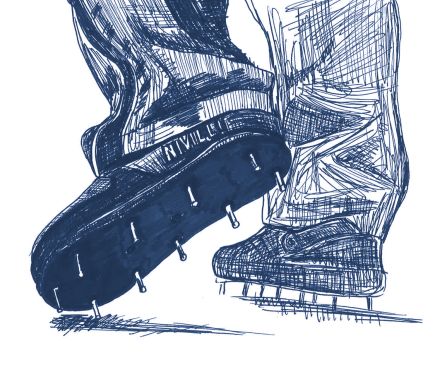
In season 11, episode 7, of the TV show "Die Höhle der Löwen" (German version of the US show Shark Tank and the UK show Dragon's Den), a young company presents a nail shoe called Nivilli, which is to be used for leveling floors and aerifying lawns.
A German patent has already been granted for the Nivilli. Thereto, a European subsequent application has been filed. On the basis of this European subsequent application, an objective possibility shall be shown, how in European proceedings the field of application of a certain technique can play a decisive role in the granting of a patent.
European subsequent application – EP3758541A1 (EP'541)
Subject-matter of protection
EP'541 sought to protect the Nivilli as a work shoe. Claim 1 of EP'541 defines the following features (cf. reference signs in brackets from Fig. 1 of EP'541 below):
M1: A work shoe (1), in particular for use in leveling work and/or filling work and/or for aerating a lawn
M2: wherein the work shoe (1) includes an opening (8) for a wearer's foot to be introduced into the work shoe (1) via the opening (8), and
M3: wherein the work shoe (1) is provided with downwardly projecting spacer elements (4).
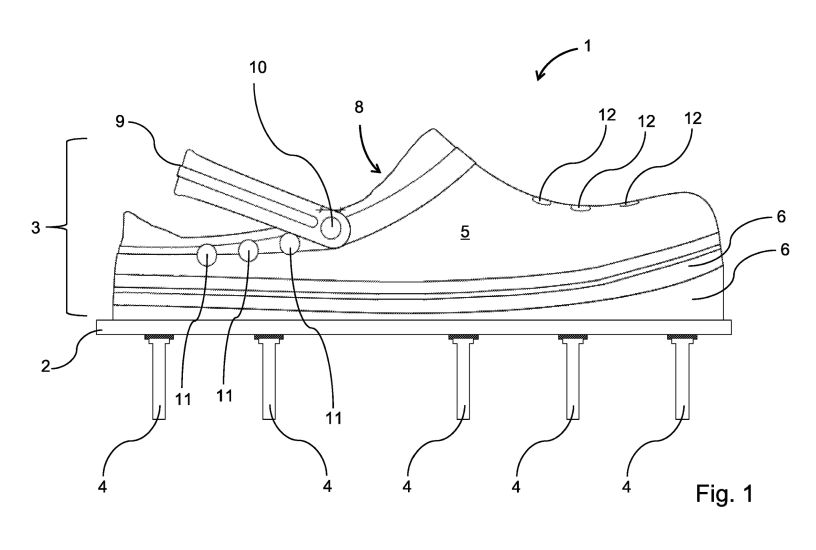
Fig. 1 – drawing from EP3758541A1
Prior Art
In the examination proceedings before the EPO, the examiner cited D1 (DE102010044816A1) and D2 (US9993045B2) as novelty-destroying for the subject-matter of claim 1 of EP'541.
D1 (DE102010044816A1)
D1 discloses a sports / work shoe of the following type (cf. claim 1 and Fig. 2 of D1 below):
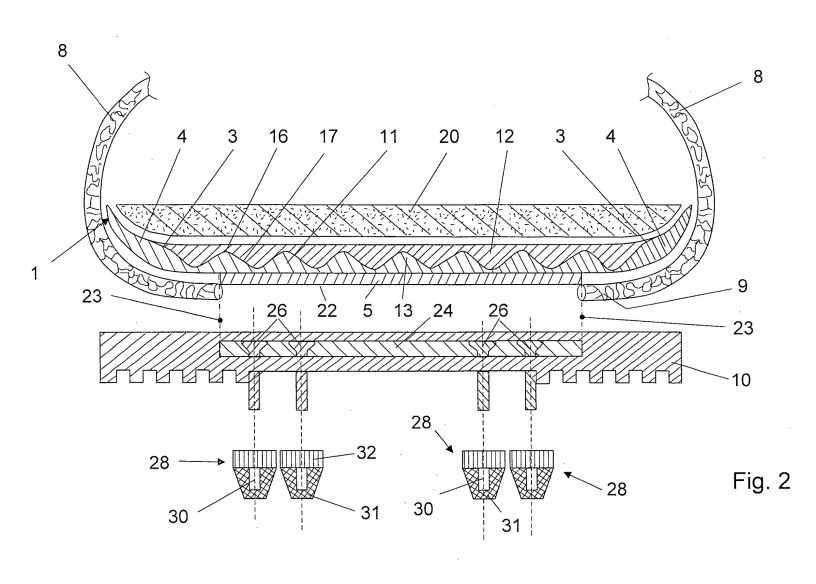
Fig. 2 – drawing from DE102010044816A1
D1 shows a work shoe according to M1, which has an shoe upper material 8 with an opening corresponding to M2 for inserting a foot into the work shoe. Furthermore, replaceable cleats 28 can be attached to the work shoe in D1, which form spacer elements according to M3.
Consequently, D1 discloses all features M1 - M3 as defined in claim 1 of EP'541.
Claim 1 of EP'541 is thus not novel over D1.
D2 (US9993045B2)
D2 includes interchangeable sandals of the following type (cf. Fig. 5E of D2 below):
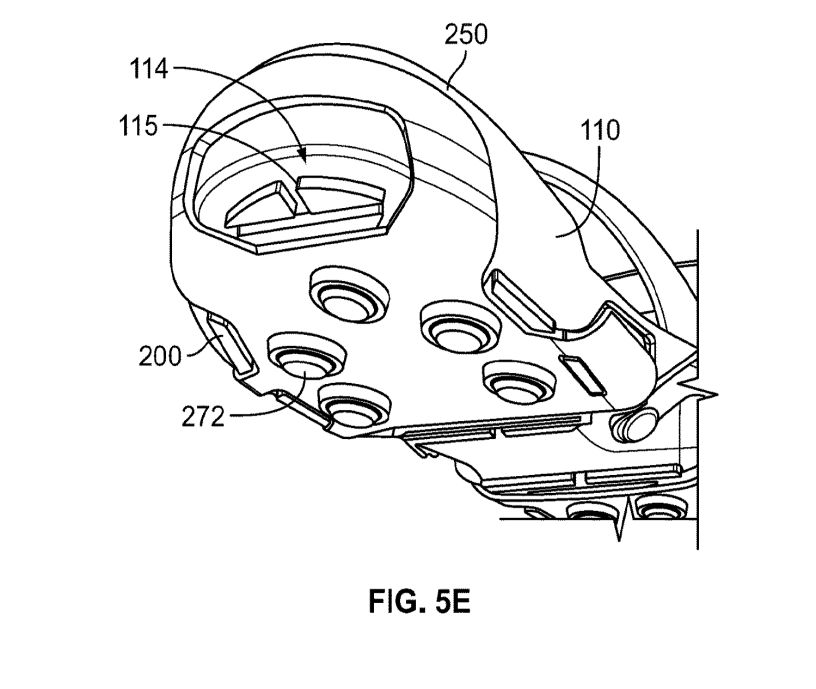
Fig. 5E – drawing from US9993045B2
However, it is questionable whether the sandals disclosed in D2 represent work shoes according to M1 at all. This is because the sandals in D2 are rather intended for leisure activities, such as fishing, hiking or kayaking (cf. column 9, lines 26 and 27 in D2). However, an opening is formed through the upper flap of the sandal of D2 for a foot to be inserted according to M2. Likewise, the cleats 272 can be understood as spacing elements according to M3.
Consequently, D2 discloses at least features M2 and M3 of claim 1 of EP'541.
From our point of view, however, the sandals from D2 can in principle also be regarded as work shoes, since fishing can be understood both as a leisure activity and as a professional activity. Thus, D2 with the sandals shown there also seems to disclose work shoes according to M1.
Following this, claim 1 of EP'541 would also not be new over D2.
D1 and D2 thus anticipate the subject-matter of claim 1 in EP'541 and the examiner will therefore not grant a European patent based on that claim 1.
So what to do? Proposal for an effective delineation from D1 and D2
One of the core ideas the Nivilli provides (cf. Fig. 1 of EP'541) is that the work shoe can be used particularly effectively and well for leveling and filling work (cf. description in EP'541, page 7, lines 3 to 6). This result is achieved by using appropriately long spacer elements with a length in a range between 20mm and 80mm – see, for example, claim 9 of EP'541.
Neither D1 nor D2 disclose (cf. figures in D1 and D2 above) that the spacer elements (D1: cleat 28; and D2: cleat 272) have a length in a range between 20mm and 80mm.
D1 does not disclose a length specification for the cleats 28. The skilled person would select a length suitable for the field of application of the sports/work shoe disclosed in D1. In this regard, D1 understands the term "sports shoe" to mean: "running shoes, soccer shoes, golf shoes, hiking shoes, sneakers and the like" and the term "work shoe" to mean: "safety shoes, military boots and shoes used for other work purposes" (cf. paragraphs [0009] and [0010] in D1). These definitions thus form requirements for the sports / work shoe of D1.
The skilled person would provide cleats 28 corresponding to these requirements. It seems inappropriate to use cleats 28 with a length of more than 20mm in the sports / work shoes of D1, because otherwise these requirements could not be met.
Thus, based on the sports / work shoe as given in D1, a skilled person would not use cleats that have a length in a range between 20mm and 80mm due to the field of application.
The skilled person could nevertheless use one of the cleats 272a to 272c shown in Fig. 5B of D2 – see the following figure – to further develop the sports / work shoe of D1 or the sandals of D2.
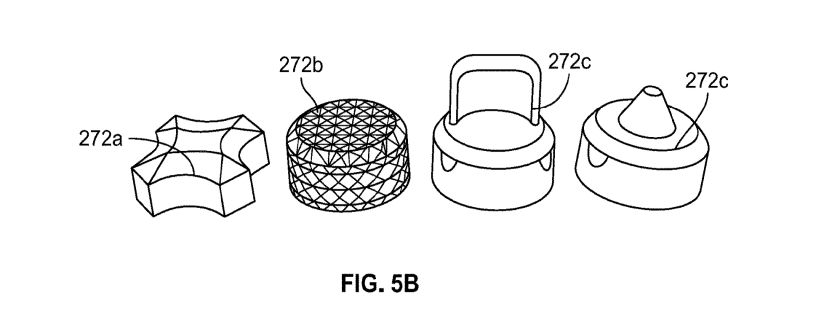
Fig. 5B – drawing from US9993045B2
The sandals shown in D2 are specifically designed for fishing, hiking, or kayaking (cf. column 9, lines 26 and 27 in D2). For these activities, long cleats 272 would obviously be less suitable or disadvantageous. The skilled person would not provide cleats 272 that exceed 20mm in length, at least for these recreational or leisure activities.
In summary, for the present invention, a specification of the length of the spacer elements in a range between 20mm and 80mm seems promising to obtain a patent grant therewith. This would correspond to a combination of claims 1 and 9 of EP'541.
A European patent could thus be obtained for the Nivilli.
Conclusion
It was shown how the field of application in the prior art can be used for a meaningful argumentation in order to make credible that the skilled person cannot come to the core idea of the present invention in an obvious way.
Note: It is indeed desired and preferred by the European Patent Office to apply a very specific scheme, the so-called Problem-Solution-Approach, in order to overcome the objection of lack of inventive step. However, the Problem-Solution-Approach is not mandatory and it can be argued more informally without using the Problem-Solution-Approach.
In summary, a limitation is necessary in the case of the Nivilli in the European proceedings, but it reflects the intended use of the present invention.
So, even with such an amended claim 1, the Nivilli would still receive a broad scope of protection. This certainly makes possible imitation of the Nivilli more difficult and gives the company an effective means of warding off or deterring imitation. This means ensures the company's success in the sales market.
Author: Julian Graf
German and European Patent Attorney
Disclaimer: The above contribution reflects the personal opinion of the author. The assessments and statements made in the article do not constitute legal advice and are provided under exclusion of any liability. If you need an assessment of an individual case, please contact the author and/or the law firm KUHNEN & WACKER.


